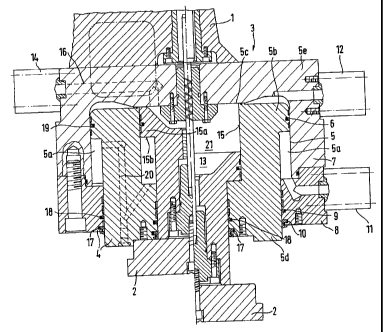Une partie des informations de ce site Web a été fournie par des sources externes. Le gouvernement du Canada n'assume aucune responsabilité concernant la précision, l'actualité ou la fiabilité des informations fournies par les sources externes. Les utilisateurs qui désirent employer cette information devraient consulter directement la source des informations. Le contenu fourni par les sources externes n'est pas assujetti aux exigences sur les langues officielles, la protection des renseignements personnels et l'accessibilité.
L'apparition de différences dans le texte et l'image des Revendications et de l'Abrégé dépend du moment auquel le document est publié. Les textes des Revendications et de l'Abrégé sont affichés :
| (12) Brevet: | (11) CA 2457177 |
|---|---|
| (54) Titre français: | CAGE DE LAMINOIR DESTINEE AU LAMINAGE DE DIFFERENTS LAMINES NECESSITANT DIFFERENTES FORCES DE LAMINAGE |
| (54) Titre anglais: | ROLLING MILL STAND FOR THE ROLLING OF DIFFERENT ROLLED STOCK WHICH REQUIRE DIFFERENT ROLLING FORCES |
| Statut: | Réputé périmé |
| (51) Classification internationale des brevets (CIB): |
|
|---|---|
| (72) Inventeurs : |
|
| (73) Titulaires : |
|
| (71) Demandeurs : |
|
| (74) Agent: | FETHERSTONHAUGH & CO. |
| (74) Co-agent: | |
| (45) Délivré: | 2010-09-07 |
| (86) Date de dépôt PCT: | 2002-08-16 |
| (87) Mise à la disponibilité du public: | 2003-03-13 |
| Requête d'examen: | 2007-05-14 |
| Licence disponible: | S.O. |
| (25) Langue des documents déposés: | Anglais |
| Traité de coopération en matière de brevets (PCT): | Oui |
|---|---|
| (86) Numéro de la demande PCT: | PCT/EP2002/009195 |
| (87) Numéro de publication internationale PCT: | WO2003/020452 |
| (85) Entrée nationale: | 2004-02-12 |
| (30) Données de priorité de la demande: | ||||||
|---|---|---|---|---|---|---|
|
L'invention concerne une cage de laminoir destinée au laminage de différents laminés nécessitant différentes forces de laminage. Cette cage comprend des cylindres de travail, des cylindres d'appui, éventuellement un dispositif de pliage destiné aux cylindres de travail et éventuellement un équipement destiné au réglage et à l'équilibrage de cylindres d'appui et des paires de cylindres de réglage (3) placés entre les montants de laminoir (1) et les empoises (2) permettent d'éviter les grandes pertes par frottement, de telle façon que les cylindres de réglage (3) soient respectivement composés d'un cylindre télescopique (4) qui renferme un premier cylindre concentrique (5) de grand diamètre pour des forces laminage élevées et un deuxième cylindre concentrique (15) de petit diamètre pour de petites forces de laminage.
The invention relates to a roll stand for rolling different rolling stock that
requires different roll separating forces. The inventive roll stand comprises
working rolls, back-up rolls, optionally a roll bending device for the working
rolls and optionally a device for adjusting and balancing the back-up rolls,
and pairs of adjustment cylinders (3) between the roll stands (1) and the
chocks (2). According to the invention, the adjustment cylinders (3) consist
of respective telescope cylinders (4), in which a first, concentric cylinder
(5) having a large diameter is provided for high roll separating forces and a
second, concentric cylinder (15) having a smaller diameter is provided for
lower roll separating forces, thereby avoiding high friction losses.
Note : Les revendications sont présentées dans la langue officielle dans laquelle elles ont été soumises.
Note : Les descriptions sont présentées dans la langue officielle dans laquelle elles ont été soumises.

Pour une meilleure compréhension de l'état de la demande ou brevet qui figure sur cette page, la rubrique Mise en garde , et les descriptions de Brevet , États administratifs , Taxes périodiques et Historique des paiements devraient être consultées.
| Titre | Date |
|---|---|
| Date de délivrance prévu | 2010-09-07 |
| (86) Date de dépôt PCT | 2002-08-16 |
| (87) Date de publication PCT | 2003-03-13 |
| (85) Entrée nationale | 2004-02-12 |
| Requête d'examen | 2007-05-14 |
| (45) Délivré | 2010-09-07 |
| Réputé périmé | 2013-08-16 |
Il n'y a pas d'historique d'abandonnement
| Type de taxes | Anniversaire | Échéance | Montant payé | Date payée |
|---|---|---|---|---|
| Le dépôt d'une demande de brevet | 400,00 $ | 2004-02-12 | ||
| Enregistrement de documents | 100,00 $ | 2004-05-13 | ||
| Taxe de maintien en état - Demande - nouvelle loi | 2 | 2004-08-16 | 100,00 $ | 2004-07-20 |
| Taxe de maintien en état - Demande - nouvelle loi | 3 | 2005-08-16 | 100,00 $ | 2005-07-22 |
| Taxe de maintien en état - Demande - nouvelle loi | 4 | 2006-08-16 | 100,00 $ | 2006-07-20 |
| Requête d'examen | 800,00 $ | 2007-05-14 | ||
| Taxe de maintien en état - Demande - nouvelle loi | 5 | 2007-08-16 | 200,00 $ | 2007-08-10 |
| Taxe de maintien en état - Demande - nouvelle loi | 6 | 2008-08-18 | 200,00 $ | 2008-08-06 |
| Taxe de maintien en état - Demande - nouvelle loi | 7 | 2009-08-17 | 200,00 $ | 2009-07-23 |
| Enregistrement de documents | 100,00 $ | 2009-08-11 | ||
| Taxe finale | 300,00 $ | 2010-06-10 | ||
| Taxe de maintien en état - Demande - nouvelle loi | 8 | 2010-08-16 | 200,00 $ | 2010-06-10 |
| Taxe de maintien en état - brevet - nouvelle loi | 9 | 2011-08-16 | 200,00 $ | 2011-08-04 |
Les titulaires actuels et antérieures au dossier sont affichés en ordre alphabétique.
| Titulaires actuels au dossier |
|---|
| SMS SIEMAG AKTIENGESELLSCHAFT |
| Titulaires antérieures au dossier |
|---|
| DENKER, WOLFGANG |
| SMS DEMAG AKTIENGESELLSCHAFT |